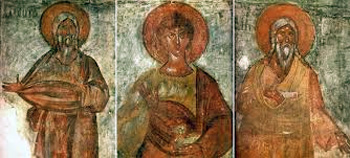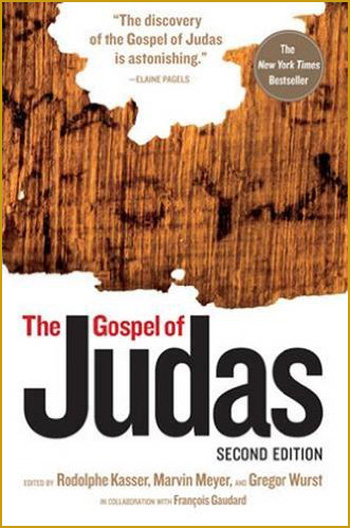Book reviews
 |
 |
 |
 |
 |
 |
 |
An Apocryphal Document of Gnostic Inspiration
Book review of The Gospel of Judas by Rodolphe Kasser, Marvin Meyer, Gregor Wurst, and Bart D. Ehrman (Washington DC: National Geographic Society, 2006) 185 pp.
In the 1970’s an ancient text was discovered in a cave in the desert of Egypt. After many years of being sold, stolen, re-sold and left to rot in a safety deposit box, it finally reached professional hands where it was restored and deciphered. The text claimed to be the Gospel of Judas, an ancient heretical document mentioned by St. Irenaeus, but with no known surviving copy.
The media quickly caught fire, building off sensationalism to attract readers to this potential challenge to conventional Catholic belief. Some went so far as to include it alongside the Dead Sea Scrolls and went along with such fanciful works as the Da Vinci Code to perpetuate the revolutionary myth that true Christianity had been suppressed by the entrenched powers of the conventional Church.
When one takes the time to study these apocryphal gospels in light of their message, historical context and actual meaning, a different conclusion emerges. The Gospel of Judas in fact is an attempted Christianization of an ancient aberrant strain of Gnosticism.
What does Gnosticism mean?
Gnosis means knowledge. Gnosticism is a current of thought that pretends to have the true knowledge of everything. It originated from the assimilation of Assyrian and Persian mythologies by Greek philosophy, which in turn was amalgamated into a branch of Judaism. Its doctrine is dualist: It believes that there were initially two equally powerful principles – one good and one evil – that created the universe.
 Gnosticism teaches that all matter is evil, created by a godlike demiurge, and that spirit alone is good. The demiurge infused inferior spirits in matter and these became men. God, then, supposedly gifted immortal spirits to certain men; only these men who possess the divine spark and awaken to the knowledge of it can hope to enjoy a paradisiacal life after death. Thus, Gnostics believed that salvation came through knowledge of one’s divine spark.
Gnosticism teaches that all matter is evil, created by a godlike demiurge, and that spirit alone is good. The demiurge infused inferior spirits in matter and these became men. God, then, supposedly gifted immortal spirits to certain men; only these men who possess the divine spark and awaken to the knowledge of it can hope to enjoy a paradisiacal life after death. Thus, Gnostics believed that salvation came through knowledge of one’s divine spark.
To support their beliefs the Gnostics developed a complex cosmology, reflecting their idea of different heavens, angels, aeons and demons, and looking to the stars for future knowledge. The Biblical figure of Seth is featured as the true inheritor of the divine spark and the Gnostics believed only the descendents of Seth possessed anything of this immortal soul. Thus, a part of the Gnostics is referred to as Sethianism.
Judas’ gospel
Gnostic beliefs are played out to the letter in The Gospel of Judas. Here we see Jesus Christ portrayed as one of the awakened sons of the “true god,” attempting to enlighten the Apostles, who erroneously worship the demiurge, the god of this world.
In the fragments of this incomplete text, Jesus elaborates a perfectly matching account of ancient Gnostic beliefs. Adam is mentioned as the archetypal man and his son Seth is called the true seed of the “self-generated,” In this story Jesus condemns the men who follow the conventional religion of this world (at the time Judaism) as paying tribute to the false usurper god Saklas.
 In this story Judas is cast as the protagonist. Of the 12 Apostles only Judas comes to understand the esoteric Gnostic message described by the Jesus. Since only Judas “truly understands” Christ, it is he who is trusted with Christ’s confidence and, ultimately, His final request. In this story Christ actually asks Judas to betray Him so that His spirit can be freed from the material prison of His body: of “the man who clothes me.” The text ends with Judas doing so, knowing that he will be cursed by those future generations who would fail to understand the “true” message of Christ.
In this story Judas is cast as the protagonist. Of the 12 Apostles only Judas comes to understand the esoteric Gnostic message described by the Jesus. Since only Judas “truly understands” Christ, it is he who is trusted with Christ’s confidence and, ultimately, His final request. In this story Christ actually asks Judas to betray Him so that His spirit can be freed from the material prison of His body: of “the man who clothes me.” The text ends with Judas doing so, knowing that he will be cursed by those future generations who would fail to understand the “true” message of Christ.
In this way the Gospel of Judas is a Gnostic warping of the traditional Catholic narrative. Judas betrays Christ because He was asked to, and Jesus’ death, far from having any redeeming value, is considered a good thing because it frees the spirit of Jesus from the corruptible material body. Creation itself is evil, and the God of the Catholic Faith himself is portrayed as a twisted usurper demon.
Problematic commentators
Following the annotated translation of the Coptic Gospel of Judas, the rest of the book is dedicated to several scholars presenting their analysis of the work. Some of the scholars in question tried to vehemently portray the text – clearly fantastical – as an equally valid alternative to the true texts of the Gospels.
The first scholar, Rodolphe Kasser, spends most of his time recounting the damage the text went through before finally reaching professional hands. At the end he comments on the value this text has to scholars of Gnostic history, but rightly admits that it is a literary fabrication.
 The second scholar, Bart D. Ehrman, takes up a decidedly different position. In the spirit of academic relativism Ehrman goes so far as to declare that the Gospel of Judas is one of the most important discoveries in the history of Christianity. Regardless of the fact that this “gospel” flat-out contradicts Christian Scriptures – it is little more than a Gnostic re-coloring of Christianity written some 200 years after the death of Judas – Ehrman treats this piece of fiction as though it deserved the same attention as Matthew, Mark, Luke and John.
The second scholar, Bart D. Ehrman, takes up a decidedly different position. In the spirit of academic relativism Ehrman goes so far as to declare that the Gospel of Judas is one of the most important discoveries in the history of Christianity. Regardless of the fact that this “gospel” flat-out contradicts Christian Scriptures – it is little more than a Gnostic re-coloring of Christianity written some 200 years after the death of Judas – Ehrman treats this piece of fiction as though it deserved the same attention as Matthew, Mark, Luke and John.
He takes its credibility for granted and, therefore, announces that the “wrongly maligned” Judas Iscariot is now poised for redemption from the misled Christians of mainstream Christianity. This author even goes so far as to disparage St. Irenaeus, who rightly investigated and condemned the early sprouting of such documents in the early Church. The great St. Irenaeus is criticized as a close-minded bigot for refusing to accept clearly fabricated works of obscure cultic imaginations.
The third scholar, Gregor Wurst, takes a more restrained approach. By studying and comparing the works of St. Irenaeus with the Gospel of Judas and other Gnostic texts, Wurst concludes that the documents are of value to scholars of Gnostic history and beliefs, but refrains from fully endorsing the message being comparable to authentic scripture.
Only the fourth scholar, Marvin Meyer, strongly acknowledges the Gospel of Judas for what it really is: a lightly Christianized Gnostic text. After comparing it to other more complete Gnostic documents, Meyer points out the similarities, proving the Gospel of Judas to be a Christianized account of Sethian beliefs.
A mask for Gnostic doctrines
The Gospel of Judas is a mask for Gnostic doctrines that were circulating in the early centuries after the coming of Our Lord. It features a cosmological timeline that was not present until around 200 A.D. (well after the death of its supposed author), an astrology that relies on Plato and a view of Genesis and creation that relies on deviant strains of preceding Sethian thought. In essence, it is another religion that is attempting to hijack the popularity of the person of Christ in order to portray Him as one of their own. The only Catholic things about the Gospel of Judas are the names of the characters.
Do not let yourself or anyone you know be confused by the sensationalist headlines surrounding this archeological curiosity. The Gospel of Judas is not an authentic gospel, it is not a carefully hidden truth that was concealed by close-minded Church authorities, and it was not even written by Judas. The theology elaborated in this text is so saturated with aberrant Gnostic Sethian beliefs that only the ignorant or the bigoted can take it as a serious challenge to Christianity. For most intents and purposes, it is a document best left in a museum.

The media quickly caught fire, building off sensationalism to attract readers to this potential challenge to conventional Catholic belief. Some went so far as to include it alongside the Dead Sea Scrolls and went along with such fanciful works as the Da Vinci Code to perpetuate the revolutionary myth that true Christianity had been suppressed by the entrenched powers of the conventional Church.
When one takes the time to study these apocryphal gospels in light of their message, historical context and actual meaning, a different conclusion emerges. The Gospel of Judas in fact is an attempted Christianization of an ancient aberrant strain of Gnosticism.
What does Gnosticism mean?
Gnosis means knowledge. Gnosticism is a current of thought that pretends to have the true knowledge of everything. It originated from the assimilation of Assyrian and Persian mythologies by Greek philosophy, which in turn was amalgamated into a branch of Judaism. Its doctrine is dualist: It believes that there were initially two equally powerful principles – one good and one evil – that created the universe.

Adam, Abel and Seth - the forebearers of Gnosis where the "good" non-materialic seed resides
To support their beliefs the Gnostics developed a complex cosmology, reflecting their idea of different heavens, angels, aeons and demons, and looking to the stars for future knowledge. The Biblical figure of Seth is featured as the true inheritor of the divine spark and the Gnostics believed only the descendents of Seth possessed anything of this immortal soul. Thus, a part of the Gnostics is referred to as Sethianism.
Judas’ gospel
Gnostic beliefs are played out to the letter in The Gospel of Judas. Here we see Jesus Christ portrayed as one of the awakened sons of the “true god,” attempting to enlighten the Apostles, who erroneously worship the demiurge, the god of this world.
In the fragments of this incomplete text, Jesus elaborates a perfectly matching account of ancient Gnostic beliefs. Adam is mentioned as the archetypal man and his son Seth is called the true seed of the “self-generated,” In this story Jesus condemns the men who follow the conventional religion of this world (at the time Judaism) as paying tribute to the false usurper god Saklas.

Judas supposedly is Christ's beloved who truly understands Him and 'betrays' Him at His request
In this way the Gospel of Judas is a Gnostic warping of the traditional Catholic narrative. Judas betrays Christ because He was asked to, and Jesus’ death, far from having any redeeming value, is considered a good thing because it frees the spirit of Jesus from the corruptible material body. Creation itself is evil, and the God of the Catholic Faith himself is portrayed as a twisted usurper demon.
Problematic commentators
Following the annotated translation of the Coptic Gospel of Judas, the rest of the book is dedicated to several scholars presenting their analysis of the work. Some of the scholars in question tried to vehemently portray the text – clearly fantastical – as an equally valid alternative to the true texts of the Gospels.
The first scholar, Rodolphe Kasser, spends most of his time recounting the damage the text went through before finally reaching professional hands. At the end he comments on the value this text has to scholars of Gnostic history, but rightly admits that it is a literary fabrication.

Coptic scholar Rodophe Kasser studies the text of the Gospel of Judas during the translation process
He takes its credibility for granted and, therefore, announces that the “wrongly maligned” Judas Iscariot is now poised for redemption from the misled Christians of mainstream Christianity. This author even goes so far as to disparage St. Irenaeus, who rightly investigated and condemned the early sprouting of such documents in the early Church. The great St. Irenaeus is criticized as a close-minded bigot for refusing to accept clearly fabricated works of obscure cultic imaginations.
The third scholar, Gregor Wurst, takes a more restrained approach. By studying and comparing the works of St. Irenaeus with the Gospel of Judas and other Gnostic texts, Wurst concludes that the documents are of value to scholars of Gnostic history and beliefs, but refrains from fully endorsing the message being comparable to authentic scripture.
Only the fourth scholar, Marvin Meyer, strongly acknowledges the Gospel of Judas for what it really is: a lightly Christianized Gnostic text. After comparing it to other more complete Gnostic documents, Meyer points out the similarities, proving the Gospel of Judas to be a Christianized account of Sethian beliefs.
A mask for Gnostic doctrines
The Gospel of Judas is a mask for Gnostic doctrines that were circulating in the early centuries after the coming of Our Lord. It features a cosmological timeline that was not present until around 200 A.D. (well after the death of its supposed author), an astrology that relies on Plato and a view of Genesis and creation that relies on deviant strains of preceding Sethian thought. In essence, it is another religion that is attempting to hijack the popularity of the person of Christ in order to portray Him as one of their own. The only Catholic things about the Gospel of Judas are the names of the characters.
Do not let yourself or anyone you know be confused by the sensationalist headlines surrounding this archeological curiosity. The Gospel of Judas is not an authentic gospel, it is not a carefully hidden truth that was concealed by close-minded Church authorities, and it was not even written by Judas. The theology elaborated in this text is so saturated with aberrant Gnostic Sethian beliefs that only the ignorant or the bigoted can take it as a serious challenge to Christianity. For most intents and purposes, it is a document best left in a museum.

Posted May 12, 2017
______________________
______________________
 Volume I |
 Volume II |
 Volume III |
 Volume IV |
 Volume V |
 Volume VI |
 Volume VII |
 Volume VIII |
 Volume IX |
 Volume XI |
 Special Edition |
 Special Edition |



